The red-blue divide is useful but reductive. A presidential campaign symbolizes a national party but doesn’t encapsulate the complexity of a given state’s local politics or experience with that party. For example, California, Hawaii, Connecticut, Vermont and Rhode Island all have Republican governors. Massachusetts had three in a row until Deval Patrick came along. Infrared Oklahoma has a Democratic governor.
What follows is a crudely scientific scale, from 1-12, of blueness and redness that dispels the current right-wing meme that this is a “center-right” country (so Obama better govern accordingly, say the very people licking their wounds). It depends on six factors: a state’s electoral vote in 2004 and in 2008, the party affiliation of its governor, its senators, the majority of its House delegation, and who controls the state legislature.
First, red and blue states as determined by the 2004 election. Easy.
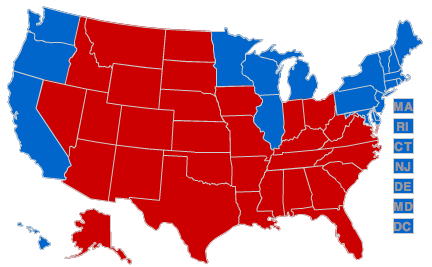
It looks scary, and it wasn’t very long ago that the country went totes cuckoo-bananas. So every blue state gets two points, and the red states get zero. Now the 2008 map.
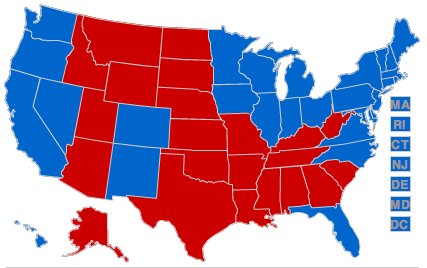
I still equate Indiana with death and trucking, but it’s harder to hate them after looking at this. So now nineteen states have 4 points, nine have 2 points and twenty-two have 0. Looking at Senators, the red states have two Republican senators, the blue states have two Democrats and the yellow states are one each. (I count Lieberman and Sanders as Democrats, and I’m assuming that both Al Franken and Jim Martin lose, just to be safe).
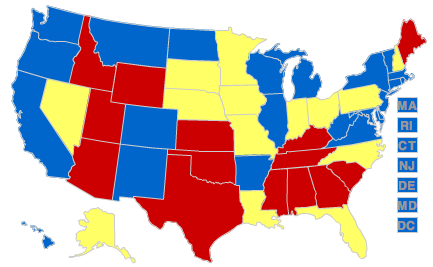
At this point, fifteen states are 6 out of 6 and thirteen states have 0. Amazing that Maine is the only state in the entire northeastern third of the country with two Republicans. (Since they’re both moderates, you could argue that this is where this model is stupid and I should suck it, but I say you should suck it). Now the states in terms of which party controls the majority of its House seats.

I totally admit that this is the most mathematically suspect one. New York, for example, has a 29-3 Democratic majority and North Dakota is 1-0, but they’re given equal weight. As are 1-1 Idaho and 9-9 Ohio (assuming Mary Jo Kilroy loses to Steve Stivers).
Similarly, the same Florida that was in the tank for Obama has a decisive 15-10 Republican split and McCain-hearting Georgia, which covers up science textbook pictures of Darwin with stickers saying ‘evolution is a theory,’ is merely 7-6 Republican. Tough.
Look at Mississippi and Arkansas, which each have 3 Democrats and 1 Republican in the House. Tennessee also edges out for the Democrats, 5-4. Bluer than you thought.
Fourteen states are now 8 out of 8, while a mere nine have 0.
Now governors:
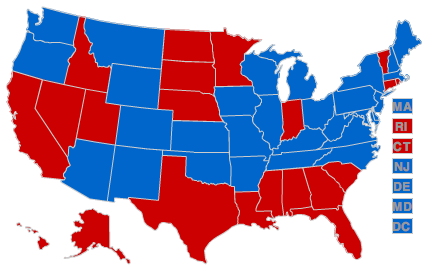
This is the GOP’s sole bright spot in New England. What really fascinates me, though, is the region Nate Silver defined as the “Highlands” (OK, AR, MO, KY, TN, WV). It not only gave McCain some of his best numbers (Obama lost every state and couldn’t even win a single county in Oklahoma) and created all sorts of hand-wringing over racism’s resilience as Hillary racked up one primary win after another there, but every single one of these six states currently has a Democratic governor. This proves my underlying point: Democrats frequently do better in their “worst” region (the South) than Republicans do in theirs (the Northeast and West Coast).
And look at the column of Democratic governorships from Montana to New Mexico. Nothing proves the Democratic resurgence in the West better than how only state in the west with a score of zero is Utah. There are now five states with 0 overall, and nine with all 10 points.
Lastly, state legislatures, with yellow indicating states where each party controls one chamber:
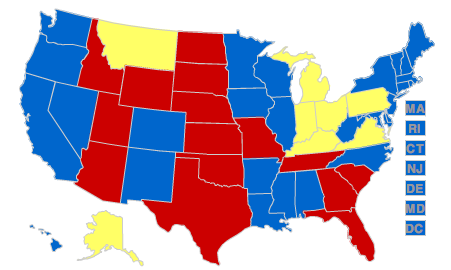
(Unicameral, officially nonpartisan Nebraska is nonetheless dominated by Republicans, and with the weirdness there I consider Alaska mixed.)
Again, the South is less than solid. An interesting pattern here is that if you take the blue states plus the yellow states, you have a roughly plausible 2012 electoral outcome map. Add Florida and Arizona and subtract Alabama and Kentucky, and it’s highly possible.
So: 8 states (WA, OR, WI, IL, NY, NJ, MA, MD) are maximally blue, 4 (GA, SC, UT and TX) are maximally red. Odd that Wisconsin, an almost archetypal swing state, should be so blue, but there it is. Below are the scores. Purple is for newly-blue states at the presidential level.
12: Illinois, Massachusetts, Maryland, Michigan, Oregon, New Jersey, New York, Washington, Wisconsin
11: Minnesota, New Hampshire, Pennsylvania
10: California, Connecticut, Colorado, Delaware, Hawaii, Maine, New Mexico, Rhode Island, Vermont, Virginia
9: Iowa
8: West Virginia
7: Nevada, North Carolina, Ohio
6: Arkansas, Indiana
5: Montana
4: Arizona, Mississippi, North Dakota, Tennessee
3: Florida, Kentucky, Louisiana, Missouri, South Dakota
2: Alaska, Alabama, Kansas, Oklahoma, Wyoming
1: Idaho, Nebraska
0: Georgia, South Carolina, Texas, Utah
To tabulate these more finely, we can replace the oversimplistic “2 points to the party that controls the majority of the state’s seats in Congress” with a more accurate percentage score. I.e., Democrats control 3 of 4 seats in Mississippi so that would be 1.5 out of 2 points, and 11 of 19 seats in Pennsylvania so that would be 1.16 out of 2 points.
That gives this scale:
MA: 12
NY: 11.79
MD: 11.75
OR: 11.6
WA: 11.5
IL: 11.26
WI: 11.25
NJ: 11.23
MI: 11.07
NH: 11
PA: 10.26
MN: 10.25
CT: 10
DE: 10
ME: 10
NM: 10
RI: 10
VT: 10
CO: 9.43
CA: 9.28
VA: 9.1
IA: 8.2
WV: 7.33
OH: 7
NV: 6.33
NC: 6.08
AR: 5.5
IN: 5.05
MT: 5
ND: 4
MO: 3.88
LA: 3.85
FL: 3.8
KY: 3.67
MS: 3.5
AZ: 3.25
TN: 3.1
SD: 3
KS: 2.5
OK: 2.4
AL: 2.29
AK: 2
WY: 2
ID: 1
NE: 1
GA: 0.92
TX: 0.75
SC: 0.67
UT: 0.67
The country is bluer than it is red. Conservative Democrats may exist in abundance, and liberal Republicans may be all but dead, but voting for one party generally puts that party’s orthodoxy in power.
Some salient points:
There is no state with a zero. There is, however a perfect twelve–Massachusetts. That’s particularly impressive considering that it’s a fairly populous state, and the scale is biased towards small states with fewer representatives. The high number of even 10s shows how many states are a single factor away from total Democratic dominance: either they have a Republican governor or voted for Bush in 2004. No such equivalent exists on the Republican side. Sure, Utah is one archconservative Democratic congressman away from a zero, and it’s a fast-growing state, but owing to its unique demographics, it’s still an anomaly–even within the West.
Several newly blue states at the presidential level do not appear to be flukes. Colorado, Virginia, New Mexico, Iowa–and to a lesser extent, Ohio, North Carolina and Nevada, have solidly Democratic tendencies.
In 2004, almost all the fast-growing states went for Bush (AZ, NV, NM, TX, FL, GA, NC, VA, UT, CO). This was ominous because they stand to gain seats after 2010. Ignoring Arizona because of McCain’s home state advantage, most of the fast-growing states went for Obama and, as stated just above, they have seen Democratic gains at all levels.
Texas, Florida and Georgia are the only populous Republican-dominated states, and the three of them could gain as many as 12 seats after the census. Florida is already turning blue at the presidential level, its Republican governor is kind of a moderate, and it may have a second Democratic senator after the next cycle. Both Georgia and Texas redistricted mid-decade to ensure GOP dominance in Congress, and it worked for a while. Texas’s State House is a mere 76-74 Republican majority and is trending the way the New York State Senate did; Obama only lost by 9 points, as well. He lost Georgia by 5 points and the Republicans edge out the Democrats only by 7-6, in seats in the US House. I think this means that the Republicans have squeezed all they can out of these two states, and the addition of more seats may result in disproportionate Democratic pickups, particularly in Texas.













